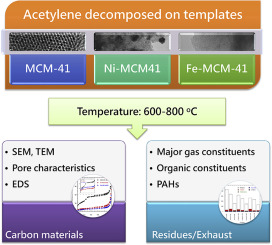Microporous and Mesoporous Materials ( IF 5.2 ) Pub Date : 2018-04-04 , DOI: 10.1016/j.micromeso.2018.04.006 Hung-Lung Chiang , Fang-Yang Wu , Pei-Hsiu Huang , Ting-Yi Lee

|
Chemical vapor deposition (CVD) was applied to the synthesis of carbon nanotubes with acetylene as the carbon source at 600–800 °C in a nitrogen atmosphere. The mesoporous material MCM-41 was selected as the template, and Ni and Fe were selected as the catalysts. MCM-41 was synthesized for the templates and used for acetylene decomposition to form carbon nanotubes at various temperatures. In Raman spectrometry analysis, the synthesized carbon nanomaterials exhibited an insignificant difference in the degree of graphitization under various pyrolysis temperatures. Results indicated that the liquid products (tar and residues) were the main fraction during acetylene decomposition. For exhaust gas, the concentration of hydrocarbons increased with an increase in temperature. NO concentrations decreased with an increase in temperature. The constituents of exhaust gases (CO, CO2, hydrocarbon and NO) were similar during the synthesis of carbon nanomaterials with various catalysts on templates. The sequence of the abundance of polycyclic aromatic hydrocarbons (PAHs) was C-Ni-MCM-41 > C-Fe-MCM-41 > C-MCM-41 system at the same pyrolysis temperature, and high PAH levels presented for high pyrolysis temperatures. For 52 volatile organic compounds (VOCs), the concentrations were C-MCM-41 > C-Fe-MCM-41 > C-Ni-MCM-41, and low concentration was determined for acetylene pyrolysis at high temperatures.
中文翻译:

乙炔在MCM-41上裂解形成碳材料的特征及其废气排放
在氮气氛中,在600–800°C的温度下,化学气相沉积(CVD)应用于以乙炔为碳源的碳纳米管的合成。选择介孔材料MCM-41作为模板,选择Ni和Fe作为催化剂。合成了MCM-41作为模板,并在不同温度下用于乙炔分解以形成碳纳米管。在拉曼光谱分析中,在各种热解温度下,合成的碳纳米材料在石墨化程度方面显示出不明显的差异。结果表明,液体产物(焦油和残渣)是乙炔分解过程中的主要馏分。对于废气,碳氢化合物的浓度随温度的升高而增加。NO浓度随温度升高而降低。如图2所示,在模板上用各种催化剂合成碳纳米材料的过程中,碳氢化合物和一氧化氮相似。在相同的热解温度下,多环芳烃(PAHs)的丰度顺序为C-Ni-MCM-41> C-Fe-MCM-41> C-MCM-41系统,高热解温度时PAH含量较高。对于52种挥发性有机化合物(VOC),其浓度为C-MCM-41> C-Fe-MCM-41> C-Ni-MCM-41,并且确定了乙炔在高温下热解的低浓度。



























 京公网安备 11010802027423号
京公网安备 11010802027423号